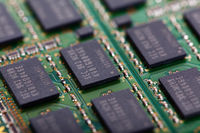Firmware
(→Graphics formats) |
(Slightly better phrasing on other similar terms that are used to this day.) |
||
| (6 intermediate revisions by 3 users not shown) | |||
| Line 4: | Line 4: | ||
|image=Computer-memory-chips.jpg | |image=Computer-memory-chips.jpg | ||
}} | }} | ||
| + | '''Firmware''' colloquially also referred to as [[BIOS]], [[Read_Only_Memory|*ROM or ROM]], is a software that usually resides on a chip that is often required for a given device to function accordingly. Without (functional) firmware, or otherwise corrupted firmware the given device may malfunction, or behave erratically. | ||
| + | |||
| + | Firmware are often programmed into CMOS, ROM, EPROM, EEPROM, which can be considered a performance/security trade-off in retrospect. A critical piece of software that resides on a physical chip is susceptible to [[Wikipedia:Software_rot|bit rot]]<ref>[https://llamamusic.com/docs/synth_binaries/synth_binaries.html Sampler Firmware Binaries - Synth & Sampler Binaries - EPROM Firmware Updates - Support]</ref>, the same as any data being stored physically, such as [[Disk_Image_Formats|disk or disc images]], and [https://qanda.digipres.org/20/what-are-the-reasons-for-saving-disk-images?show=183 why] should these be backed up. These days, especially x86 PC peripherals, these firmware may also reside as files on users' storage mediums (e.g. hard disk or SSD), in which the driver within the [[Operating Systems|Operating System]] uses it to directly interface with the hardware. | ||
| + | |||
| + | [[Emulation_Software|Emulation Software]] may also require firmware for more optimal emulation. Technically, "LLE" or Low-Level Emulation requires firmware, "HLE" or High-Level Emulation however, may not require firmware.<ref>[https://alexaltea.github.io/blog/posts/2018-04-18-lle-vs-hle/ LLE vs HLE and their tradeoffs - Alexandro Sanchez]</ref> Some virtualization software may also require firmware to allow software within the virtualized environment to make system calls that are specific to that firmware.<ref>[https://github.com/qemu/qemu/blob/master/pc-bios/README README - QEMU on GitHub]</ref> | ||
== General firmware types == | == General firmware types == | ||
* [[BIOS]] | * [[BIOS]] | ||
| + | * [[coreboot]] | ||
| + | * [[Libreboot]] | ||
| + | * [[qboot]] | ||
* [[UEFI]] | * [[UEFI]] | ||
| Line 13: | Line 21: | ||
* [[ESP8266 Wifi module firmware]] | * [[ESP8266 Wifi module firmware]] | ||
| + | * [[LG Smart TV firmware package]] | ||
== Graphics formats == | == Graphics formats == | ||
| Line 18: | Line 27: | ||
* [[Apple volume label image]] | * [[Apple volume label image]] | ||
* [[Award BIOS logo]] | * [[Award BIOS logo]] | ||
| + | * [[BootSkin Vista]] | ||
| + | * [[BootSkin XP]] | ||
* [[GLE]] | * [[GLE]] | ||
* [[GRFX]] | * [[GRFX]] | ||
| Line 23: | Line 34: | ||
* [[LSS16]] | * [[LSS16]] | ||
* [[OLPC 565]] | * [[OLPC 565]] | ||
| + | |||
| + | == References == | ||
| + | <references/> | ||
== Related things == | == Related things == | ||
| Line 30: | Line 44: | ||
== Links == | == Links == | ||
* [https://01.org/linuxgraphics/documentation/2013-intel-core-processor-family Documentation of 2013 Intel graphics processors] | * [https://01.org/linuxgraphics/documentation/2013-intel-core-processor-family Documentation of 2013 Intel graphics processors] | ||
| + | * [http://binwalk.org/ Binwalk] - Firmware analysis tool | ||
| + | |||
| + | [[Category:Booting]] | ||
Latest revision as of 08:24, 2 August 2025
Firmware colloquially also referred to as BIOS, *ROM or ROM, is a software that usually resides on a chip that is often required for a given device to function accordingly. Without (functional) firmware, or otherwise corrupted firmware the given device may malfunction, or behave erratically.
Firmware are often programmed into CMOS, ROM, EPROM, EEPROM, which can be considered a performance/security trade-off in retrospect. A critical piece of software that resides on a physical chip is susceptible to bit rot[1], the same as any data being stored physically, such as disk or disc images, and why should these be backed up. These days, especially x86 PC peripherals, these firmware may also reside as files on users' storage mediums (e.g. hard disk or SSD), in which the driver within the Operating System uses it to directly interface with the hardware.
Emulation Software may also require firmware for more optimal emulation. Technically, "LLE" or Low-Level Emulation requires firmware, "HLE" or High-Level Emulation however, may not require firmware.[2] Some virtualization software may also require firmware to allow software within the virtualized environment to make system calls that are specific to that firmware.[3]
Contents |
[edit] General firmware types
[edit] Firmware for specific hardware
[edit] Graphics formats
Graphics formats associated with firmware or boot processes
- Apple volume label image
- Award BIOS logo
- BootSkin Vista
- BootSkin XP
- GLE
- GRFX
- HTC splashscreen
- LSS16
- OLPC 565
[edit] References
- ↑ Sampler Firmware Binaries - Synth & Sampler Binaries - EPROM Firmware Updates - Support
- ↑ LLE vs HLE and their tradeoffs - Alexandro Sanchez
- ↑ README - QEMU on GitHub
[edit] Related things
[edit] Links
- Documentation of 2013 Intel graphics processors
- Binwalk - Firmware analysis tool
